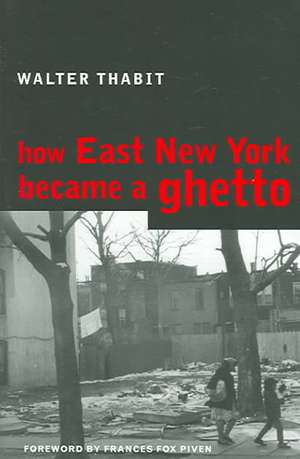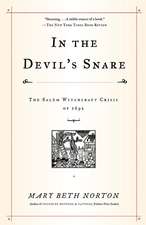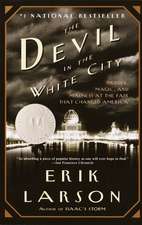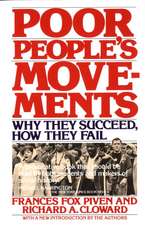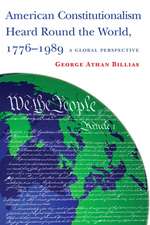How East New York Became a Ghetto
Autor Walter Thabit, Frances Fox Pivenen Limba Engleză Paperback – 31 mar 2005
| Toate formatele și edițiile | Preț | Express |
|---|---|---|
| Paperback (1) | 241.64 lei 6-8 săpt. | |
| MI – New York University – 31 mar 2005 | 241.64 lei 6-8 săpt. | |
| Hardback (1) | 528.69 lei 6-8 săpt. | |
| MI – New York University – 31 iul 2003 | 528.69 lei 6-8 săpt. |
Preț: 241.64 lei
Nou
Puncte Express: 362
Preț estimativ în valută:
46.24€ • 50.21$ • 38.84£
46.24€ • 50.21$ • 38.84£
Carte tipărită la comandă
Livrare economică 22 aprilie-06 mai
Preluare comenzi: 021 569.72.76
Specificații
ISBN-13: 9780814782675
ISBN-10: 0814782671
Pagini: 304
Dimensiuni: 152 x 227 x 24 mm
Greutate: 0.41 kg
Ediția:Revised
Editura: MI – New York University
ISBN-10: 0814782671
Pagini: 304
Dimensiuni: 152 x 227 x 24 mm
Greutate: 0.41 kg
Ediția:Revised
Editura: MI – New York University
Recenzii
Thabit emphasizes the central role of local institutions in contributing to urban disinvestment and decline.
Journal of Urban History "Walter Thabit has written a highly personal and compelling piece of retrospective analysis."Journal of the American Planning Association "Thabit's writing is lucid and heartfelt."
Urban Studies "An excellent source of data and intelligence on the formation of ghettos and the life and struggle within them."
Science & Society "How East New York Became a Ghetto describes the shift of East New York from a working-class immigrant neighborhood to a largely black and Puerto Rican one, and shows how a series of racially biased policies caused the deterioration of this once-flourishing area."
Arab-American Affairs "An interesting and worthwhile read, especially for its descriptions."Supplement "Walter Thabit's book works as a slice of urban sociology, history, and political science. It should whet the appetites of students and scholars to inquire into the longue duree of the subject more extensively."
New York HistoryThe book powerfully coveys the forces behind the ghettoization of one urban community and illustrates the difficulties of community development.
Urban History Review. "A comprehensive account of the decline of East New York in Brooklyn into a typical urban slum and of the efforts since the 1960s to redevelop the neighborhood. Anyone interested in urban social problems and improving the quality of life for urban poor should read this astounding analysis of urban decay and rebirth."
Multicultural Review "Thabit does a Herculean task of documenting the various factors that led to the ghettoization of East New York."
Progressive Planning "Thabit is in a unique position to document the destruction of the once working class Brooklyn neighborhood. . . Toward the book's conclusion, Thabit sounds a faint note of hope to the emerging community groups."
New York "This thoughtful, important analysis is recommended for academics, professionals, and a concerned public library audience."
Library Journal "Walter Thabit eloquently tells the story of East New York, a neighborhood in eastern Brooklyn, complementing his close observation of events in the neighborhood with astute analyses of the bearing of larger forces on this big city slum. Events in East New York reveal in microcosm the turbulent national forces that have determined the fate of inner city ghettos across the country over the past 40 years."
from the Foreword by Frances Fox Piven "The grim descriptions of civil neglect, community disorganization and institutional racism make this a difficult read, particularly when one realizes that this is the story that can be told about thousands of other neighborhoods in scores of citiies by hundreds of people. Perhaps if more planners like Thabit had told their stories, we might not have found oruselves in this predicament."
ADPSR NY
"Thabit emphasizes the central role of local institutions in contributing to urban disinvestment and decline." -- Journal of Urban History "Walter Thabit has written a highly personal and compelling piece of retrospective analysis."--Journal of the American Planning Association "Thabit's writing is lucid and heartfelt." --Urban Studies "An excellent source of data and intelligence on the formation of ghettos and the life and struggle within them." --Science & Society "How East New York Became a Ghetto describes the shift of East New York from a working-class immigrant neighborhood to a largely black and Puerto Rican one, and shows how a series of racially biased policies caused the deterioration of this once-flourishing area." --Arab-American Affairs "An interesting and worthwhile read, especially for its descriptions."--Supplement "Walter Thabit's book works as a slice of urban sociology, history, and political science. It should whet the appetites of students and scholars to inquire into the longue duree of the subject more extensively." --New York History"The book powerfully coveys the forces behind the ghettoization of one urban community and illustrates the difficulties of community development." -- Urban History Review. "A comprehensive account of the decline of East New York in Brooklyn into a typical urban slum and of the efforts since the 1960s to redevelop the neighborhood. Anyone interested in urban social problems and improving the quality of life for urban poor should read this astounding analysis of urban decay and rebirth." --Multicultural Review "Thabit does a Herculean task of documenting the various factors that led to the ghettoization of East New York." --Progressive Planning "Thabit is in a unique position to document the destruction of the once working class Brooklyn neighborhood... Toward the book's conclusion, Thabit sounds a faint note of hope to the emerging community groups." -- New York "This thoughtful, important analysis is recommended for academics, professionals, and a concerned public library audience." --Library Journal "Walter Thabit eloquently tells the story of East New York, a neighborhood in eastern Brooklyn, complementing his close observation of events in the neighborhood with astute analyses of the bearing of larger forces on this big city slum. Events in East New York reveal in microcosm the turbulent national forces that have determined the fate of inner city ghettos across the country over the past 40 years." --from the Foreword by Frances Fox Piven "The grim descriptions of civil neglect, community disorganization and institutional racism make this a difficult read, particularly when one realizes that this is the story that can be told about thousands of other neighborhoods in scores of citiies by hundreds of people. Perhaps if more planners like Thabit had told their stories, we might not have found oruselves in this predicament." --ADPSR NY
Journal of Urban History "Walter Thabit has written a highly personal and compelling piece of retrospective analysis."Journal of the American Planning Association "Thabit's writing is lucid and heartfelt."
Urban Studies "An excellent source of data and intelligence on the formation of ghettos and the life and struggle within them."
Science & Society "How East New York Became a Ghetto describes the shift of East New York from a working-class immigrant neighborhood to a largely black and Puerto Rican one, and shows how a series of racially biased policies caused the deterioration of this once-flourishing area."
Arab-American Affairs "An interesting and worthwhile read, especially for its descriptions."Supplement "Walter Thabit's book works as a slice of urban sociology, history, and political science. It should whet the appetites of students and scholars to inquire into the longue duree of the subject more extensively."
New York HistoryThe book powerfully coveys the forces behind the ghettoization of one urban community and illustrates the difficulties of community development.
Urban History Review. "A comprehensive account of the decline of East New York in Brooklyn into a typical urban slum and of the efforts since the 1960s to redevelop the neighborhood. Anyone interested in urban social problems and improving the quality of life for urban poor should read this astounding analysis of urban decay and rebirth."
Multicultural Review "Thabit does a Herculean task of documenting the various factors that led to the ghettoization of East New York."
Progressive Planning "Thabit is in a unique position to document the destruction of the once working class Brooklyn neighborhood. . . Toward the book's conclusion, Thabit sounds a faint note of hope to the emerging community groups."
New York "This thoughtful, important analysis is recommended for academics, professionals, and a concerned public library audience."
Library Journal "Walter Thabit eloquently tells the story of East New York, a neighborhood in eastern Brooklyn, complementing his close observation of events in the neighborhood with astute analyses of the bearing of larger forces on this big city slum. Events in East New York reveal in microcosm the turbulent national forces that have determined the fate of inner city ghettos across the country over the past 40 years."
from the Foreword by Frances Fox Piven "The grim descriptions of civil neglect, community disorganization and institutional racism make this a difficult read, particularly when one realizes that this is the story that can be told about thousands of other neighborhoods in scores of citiies by hundreds of people. Perhaps if more planners like Thabit had told their stories, we might not have found oruselves in this predicament."
ADPSR NY
"Thabit emphasizes the central role of local institutions in contributing to urban disinvestment and decline." -- Journal of Urban History "Walter Thabit has written a highly personal and compelling piece of retrospective analysis."--Journal of the American Planning Association "Thabit's writing is lucid and heartfelt." --Urban Studies "An excellent source of data and intelligence on the formation of ghettos and the life and struggle within them." --Science & Society "How East New York Became a Ghetto describes the shift of East New York from a working-class immigrant neighborhood to a largely black and Puerto Rican one, and shows how a series of racially biased policies caused the deterioration of this once-flourishing area." --Arab-American Affairs "An interesting and worthwhile read, especially for its descriptions."--Supplement "Walter Thabit's book works as a slice of urban sociology, history, and political science. It should whet the appetites of students and scholars to inquire into the longue duree of the subject more extensively." --New York History"The book powerfully coveys the forces behind the ghettoization of one urban community and illustrates the difficulties of community development." -- Urban History Review. "A comprehensive account of the decline of East New York in Brooklyn into a typical urban slum and of the efforts since the 1960s to redevelop the neighborhood. Anyone interested in urban social problems and improving the quality of life for urban poor should read this astounding analysis of urban decay and rebirth." --Multicultural Review "Thabit does a Herculean task of documenting the various factors that led to the ghettoization of East New York." --Progressive Planning "Thabit is in a unique position to document the destruction of the once working class Brooklyn neighborhood... Toward the book's conclusion, Thabit sounds a faint note of hope to the emerging community groups." -- New York "This thoughtful, important analysis is recommended for academics, professionals, and a concerned public library audience." --Library Journal "Walter Thabit eloquently tells the story of East New York, a neighborhood in eastern Brooklyn, complementing his close observation of events in the neighborhood with astute analyses of the bearing of larger forces on this big city slum. Events in East New York reveal in microcosm the turbulent national forces that have determined the fate of inner city ghettos across the country over the past 40 years." --from the Foreword by Frances Fox Piven "The grim descriptions of civil neglect, community disorganization and institutional racism make this a difficult read, particularly when one realizes that this is the story that can be told about thousands of other neighborhoods in scores of citiies by hundreds of people. Perhaps if more planners like Thabit had told their stories, we might not have found oruselves in this predicament." --ADPSR NY
Notă biografică
Walter Thabit has 35 years of experience in housing, renewal, community planning, city planning, and anti-poverty projects. He lives in New York City.
